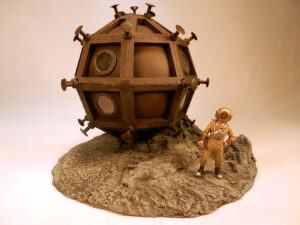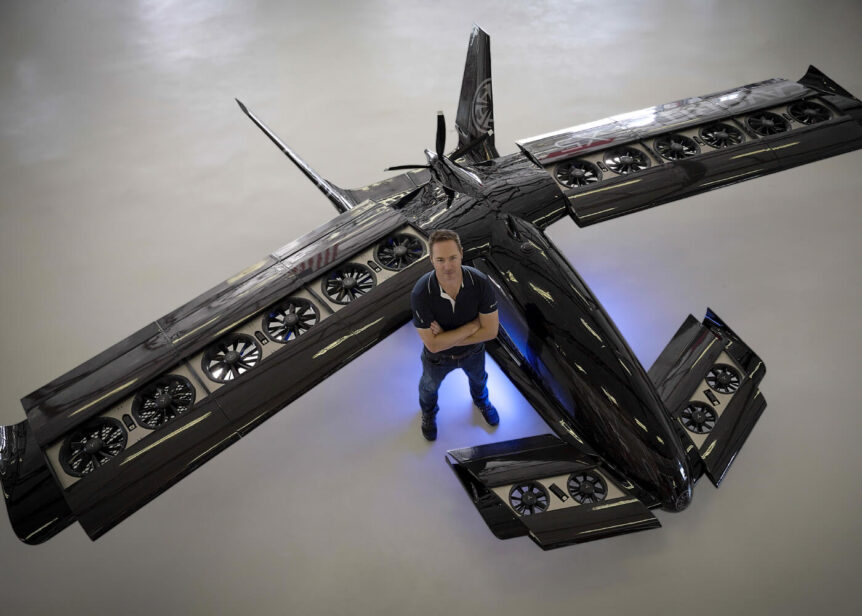The Cavorite X5, now in developmental test flights, that came from the inspiration of H. G. Wells. Cavorite was the mysterious metal in Wells’ First Men in the Moon, discovered by Dr. Cavor. He explains it to his friends, who are attempting to reach the earthly satellite:
“Well, so soon as it reached a temperature of 60 Fahr[enheit], and the process of its manufacture was complete, the air above it, the portions of roof and ceiling and floor above it ceased to have weight. I suppose you know – everybody knows nowadays – that, as a usual thing, the air has weight, that it presses on everything at the surface of the earth, presses in all directions, with a pressure of fourteen and a half pounds to the square inch? ”
“I know that,” said I. “Go on.”

Model of the Cavorite Sphere that transported Wells’ explorers to the moon by its gravity-defying characteristics
“I know that too,” he remarked. “Only this shows you how useless knowledge is unless you apply it. You see, over our Cavorite this ceased to be the case, the air there ceased to exert any pressure, and the air round it and not over the Cavorite was exerting a pressure of fourteen pounds and a half to the square in upon this suddenly weightless air. Ah! You begin to see! The air all about the Cavorite crushed in upon the air above it with irresistible force. The air above the Cavorite was forced upward violently, the air that rushed in to replace it immediately lost weight, ceased to exert any pressure, followed suit, blew the ceiling through and the roof off.”
As with many of Wells’ inventions, the material seems to have unintended consequences that make it a highly hazardous substance.
The Cavorite X5
Hoping to defy gravity in much the same way as its literary namesake, but with less disastrous results, the Cavorite X5 is a different approach to combining vertical lift and horizontal thrust. Its patented fan-in-wing design is perhaps the ultimate in “blown-wing” design. Leading and trailing edges of the wing slide apart and a series of horizontally-aligned ducted fans blow downward to lift the X5. Transition to forward flight involves revving the tail-mounted pusher propeller while simultaneously closing the wing opening. In its “clean” configuration, its makers claim, the X5 can achieve a cruising speed of 450 kilometers per hour, or 240 knots (276 miles per hour).
The tricky transition has been demonstrated with a 50-percent scale demonstrator, and further in wind tunnel tests at the ACE Climatic Wind Tunnel in Oshawa, Canada. Revolution.aero.com, reports, “Aircraft performance exceeded our expectation,” said Brandon Robinson, CEO, Horizon. “We explored forward speeds of up to almost 100 km/h [62 mph], measuring aerodynamic forces, control authority, and mechanical system function with the wings open at varying fan speeds.”
The craft can carry one pilot and four passengers about 250 miles, an hour’s trip and further than most eVTOLs (electric Vertical Take Off and Landing) aircraft can manage.
The X5 lifts with 12 fans in the wing and four in the canard. It moves forward with a large pusher propeller. eVTOLnews.com reports, “Electric Motors: 17 or more. There are electric motors for the retractable landing gear, retractable ducted wing covering (possibly some to open/close the canopy and gull-wing doors)
“Power source: Hybrid-electric gas engine to create electricity for all electrical systems on-board, a back-up motor in case the main gas engine fails and there is also a battery pack system on-board.”
Additional safety, if all else fails, by the craft being able to glide to a conventional landing.
Considering the complexity of the machine and its promised performance, one wonders if Horizon Aircraft, the parent company, can pull this off. Perhaps a look at previous accomplishments can answer the question.
Big Engine Seabees
One problem faced by owners of vintage aircraft is finding parts for their 1930-type engines. Brandon’s 1946 Republic Seabee, a mid-century four-seat amphibian, needed a rebuild for the old Franklin or a better replacement. He turned to converting a modern General Motors LS-1, which cost a fourth of its aircraft equivalent, produced higher horsepower, and used less fuel. Overhauling a large aircraft engine would cost $40,000 to $50,000, which one could obtain a GM “crate” engine for $10,000 to $18,000. His improved Seabee became the inspiration for the Cavorite X3, a private venture amphibian that was a great improvement of the older craft (but was not built in full scale).
The X5 was a logical extension into the idea of a vertical takeoff and landing vehicle, with the potential to eliminate landing fields altogether. Let’s see where this ever-expanding vision takes Cavorite.

